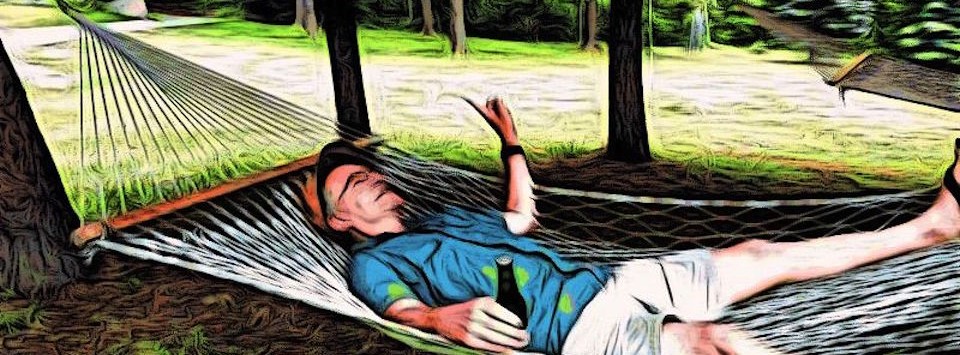At the Cusp of a New Year
Just when you think you know a guy...

That's me, McCoy Fields: figuring out the angles.
Here we are, at the cusp of 2026.
Yes, I like the word "cusp" ⏤ it's like the best misspelling of "cups" ever. Maybe I had too much coffee today. Anyway. Here we are, at the cups of 2026, a time when us mere mortals slow down and take stock of the year that was and maybe, just maybe, relax a little bit.
Not Jeff Mann, The Real Yard Ramp Guy.
I've known Jeff some 15 years now. Long enough to watch him build something special. Always admired his innovative entrepreneurial spirit, his honesty, his integrity. But what I never knew before, what he apparently kept tucked away like one of those ramps in a warehouse between seasons: the guy sees a holiday as an opportunity to do more.
Just when you think you know a guy, eh?
Here's Jeff at the holiday: He's thinking about what's next. Oh, not just thinking. He's working on it.
Now, I'm not at liberty to share the details just yet. Jeff's asked me to keep quiet about the particulars. (Come to think of it, Maggie prefers me this way, too. She's been working on that project, with varying degrees of success, for some 30 years now. Hmmm.) But what I can and want to share are two things:
- Jeff is not just The Yard Ramp Guy. He's actually the guy behind the Guy. Ends up, he's running a full-blown marketing agency. Go figure. Check out Team22Inc.com. That enterprise looks to be putting a lot of sizzle in a lot of steak. Digital marketing, SEO, web dev, lead generation. The whole nine yards. (Go right ahead and insert your own "nine yard ramps" play on words here. Didn't work for me either.)
- He's asked me to be his pitchman for some of that new stuff in the works.
Can't tell you how flattered I am by that. Honored, really.
Now, I might be a shameless PR dude, spinning yarns and polishing brands when I'm not working at the distribution center. But I'm otherwise quiet and reserved. Just like Maggie likes. So, I'm honored to help Jeff tell his story. You just might be seeing more of me this year.
I have a hunch that 2026 is shaping up to be something extraordinary. Big ideas are moving from the pipe dream to the tangible. Stay tuned, friends.
Happy cusp of 2026.
The Yard Ramp Guy | A 2025 Year-End Clearance Rhyme
This week, my friend The Yard Ramp Guy puts his cusp of the year into verse. (Some joke almost worked here about "vice versa" but didn't. And so it goes.)
Click HERE to have your first Yard Ramp Guy/Bing Crosby moment.

The Machines Are Here. And They’re Pretty Darn Helpful.
But They Kept The Humans Around

McCoy Fields: part man, part machine, still two left thumbs in the garden.
I used to think “AI” stood for “Absolutely Ineffective,” back when it meant autocorrect changing “yard ramp” to “yard lamp” in emails. (Though to be fair, who wouldn’t want a 20,000-lb steel lamp on their loading dock?)
But now? Things have changed.
Jeff Mann, The Real Yard Ramp Guy, in his endless pursuit of helping people move heavy things efficiently, recently told me that he's decided to team up with the bots. Yep: artificial intelligence, machine learning, smart algorithms… whatever you want to call it, he's using it to make your life easier.
Not Replacing People. Enhancing Service.
We’re not talking about robo-salesmen barking out ramp specs in a monotone. Over the next months, The Yard Ramp Guy will be adding:
- Smarter search tools that help you find ramps faster.
- Intelligent suggestions for ramp rentals in your region (like Wheeling, West Virginia, my personal favorite place) —or anywhere your business happens to park itself).
- Better customer response times, even outside office hours.
It’s not some cold, robotic takeover. It’s human + machine, working together to get you the right ramp, in the right place, at the right time. That’s pretty darn cool.
Still Human. Still Helpful.
Jeff Mann assures me that The Yard Ramp Guy hasn’t lost his personal touch. You’ll still talk to real people who actually know what a yard ramp is and how to spell it. The AI just clears the path a little faster.
Think of it like this: AI is the forklift, and the humans are still doing the steering.
The Bottom Line
Technology is only as good as the hands it’s in. And lucky for us, it’s in The Yard Ramp Guy’s hands: steady, experienced, and always pointed toward helping folks get the job done.
So if you see a few smart tools on the website, don’t be alarmed. It’s not the rise of the machines. It’s the rise of better service.
The Yard Ramp Guy | Renting an Industrial Yard Ramp: Key Benefits
This week, my friend The Yard Ramp Guy gives me an advanced primer on the benefits of renting a portable yard ramp from that fine company.
Click HERE to read a description that'll make you want to click and call The Guy.

Archives: The Perils of Amazing Automation
Or: Power (Sometimes) to the People

My good friend Jeff Mann, the true Yard Ramp Guy, has asked me to revisit some of my original posts. This week in my From the Archives series: not all inventions eliminate jobs. It only seems that way.
My friend Jeff (the actual Yard Ramp Guy) recently sent me a video filled with new construction machines: machines that can lay brick roads, and lay train tracks automatically, and place bridge segments from above, and plant rice faster than any human.
This is nothing new, of course. A great deal of history's inventions has resulted in lost jobs. Computers killed the typesetter. Robots have killed factory manufacturing jobs. Tractors, fertilizer, and other farming equipment are, by far, the biggest job killer.
In medieval Europe, more than 90% of workers were farmers. In 1820, 72% of Americans farmed. Today, less than two percent of Americans farm. Most of the displaced workers from these industries have ended up in service industry jobs in America.

Whole World in Tech's Hands?
A few factors usually counteract these job losses.
First, population growth. As populations increase, so does the economy and demand for goods and, therefore, jobs. In fact, one of the central premises of most economic plans is that population will keep increasing, thereby growing the economy.
Second, not all inventions eliminate jobs. Some actually create more jobs. This isn't always a good thing, of course. One of the most impactful job-creating inventions in all of history was the cotton gin. It created countless jobs by making cotton growing much more profitable and feasible. Unfortunately, slaves took on almost all of those jobs making American slavery that much more profitable and heinous.
That said, other job-creating inventions aren't nearly so bad. The Internet is a great example of this. Unfortunately, that's all about to change. Upcoming labor-saving technologies are reaching a point where they'll actually start costing net jobs.
More on that next time.
Yard Ramp Guy Blog: About the Warranty
This week, my friend The Yard Ramp Guy explores and expands on the Warranty details.
Click HERE to read the fine print.

Archives: Tokyo Gets Drained
Flooding (you with) Information

My good friend Jeff Mann, the true Yard Ramp Guy, has asked me to revisit some of my original posts. This week in my From the Archives series: my entry that closed out the year. (Oh, the year was 2015.)
 There's an enormous underground chamber just north of Tokyo. The Underground Temple—also known as the G-Cans Project, or the Metropolitan Area Outer Underground Discharge Channel—is a flood water diversion facility.
There's an enormous underground chamber just north of Tokyo. The Underground Temple—also known as the G-Cans Project, or the Metropolitan Area Outer Underground Discharge Channel—is a flood water diversion facility.
“Enormous” might be an understatement. It’s more than 25 meters high and 177 meters long. The concrete room is held up by 59 immense, 500-ton concrete pillars. In addition to the main chamber, there are five huge underground silos, each 65 meters deep and 32 m in diameter. You could quite literally fit Godzilla in one of those.
Construction on it began in 1992 and didn't complete until 2009. The whole thing is essentially the world's largest drain. The silos and the Temple are linked by hundreds of miles of underground pipes. The entire complex is nearly four miles across.
Tokyo has suffered from frequent floods throughout its history—not just from heavy rain, but also from typhoons and tornadoes. G-Cans was built to withstand even the most massive, once-every-other-century floods. Its 14,000 hp turbines and 78 pumps are capable of pumping more than 200 tons of water per second into the nearby Edogawa River.

"It was THIS big!"
The architects and construction crew faced a number of major difficulties in the construction. Earthquake proofing was one of the biggest hurdles. Another: preventing buckling and sagging in the ground overhead as they dug out the complex; it is directly underneath a city, after all.
There was a little criticism about the steep price tag ($2 billion) and the fact that Tokyo already possessed significant flooding defenses. Still, given how prone to natural disasters the city is, I certainly think they made the right call.
So, they have the flood prevention thing covered. Of course, there are still earthquakes, volcanic eruptions, tsunamis, typhoons, Godzilla, and those horrifying giant Japanese hornets to worry about.
Yard Ramp Guy Blog: The Year in Review in Verse
This week, my friend The Yard Ramp Guy is frisky with his song rewrites.
Click HERE to sing along.






